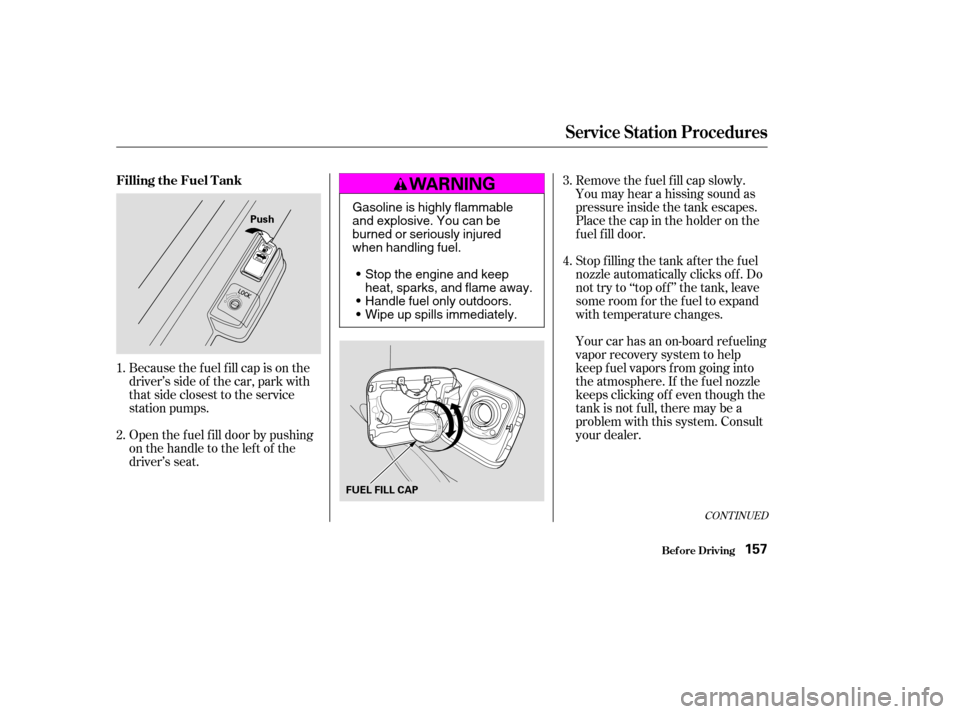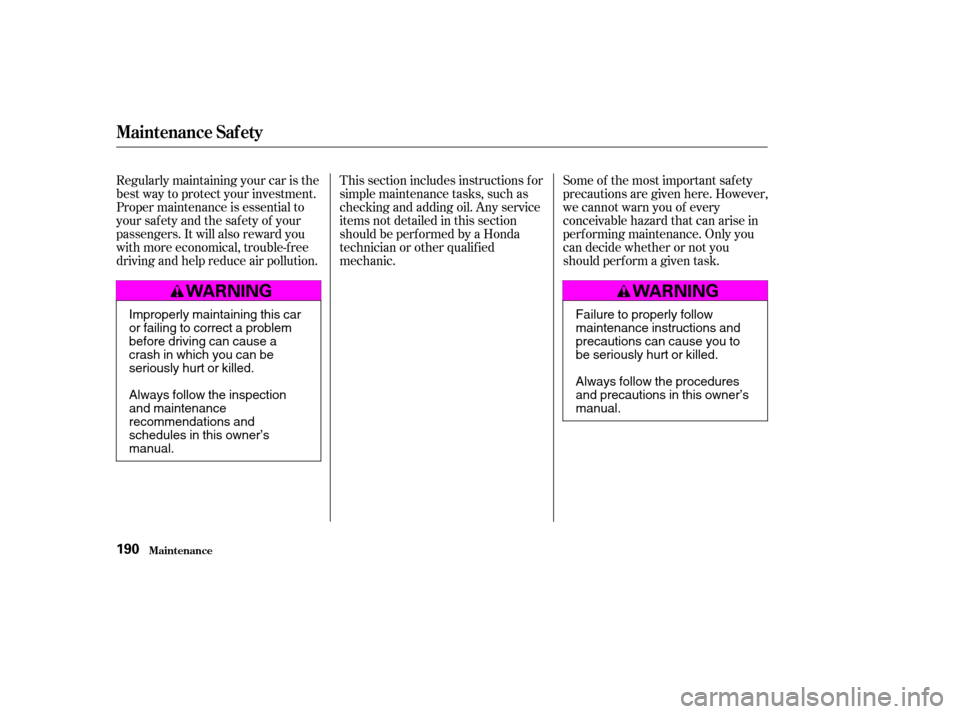Page 52 of 302

Together, airbags and
seat belts provide the best
protection.
Tampering could cause
the airbags to deploy, possibly
causing very serious injury. See page f or f urther inf ormation
and precautions relating to your
airbags.
If rain or spilled water
soaks into a seat-back, it can
prevent the side airbag system
f rom working properly. Improperly
replacing or covering f ront seat-
back covers can prevent your side
airbags f rom inf lating during a
collision.
Any
airbag that has deployed must be
replaced along with the seat belt
tensioners, control unit and other
related parts. Do not try to remove
or replace any airbag by yourself.
This must be done by a Honda
dealer or a knowledgeable body
shop.
Take your car to an
authorized Honda dealer as soon
as possible. If you ignore this
indication, the airbags might not
inf late when you need them.
Your f ront airbag system and side
airbag system (if equipped) are
virtually maintenance-f ree, and there
are no parts you can safely service.
However, you must have your car
serviced if :
164
Airbag Service Additional Saf ety Precautions
Donotattempttodeactivateyour
airbags.
Do not t amper wit h airbagcomponent s or wiring f or any
reason.
Do not expose t he f ront seat -backsto water. Do not cover or replace f ront seat -
back covers wit hout consult ing aHonda dealer.
Your airbags ever inf late.
T he SRS indicat or light alert s yout o a problem.
Additional Inf ormation About Your Airbags
Driver and Passenger Saf ety54
�����—�����—�����y�
����
��������y���
�(���%�������y���������y
Page 151 of 302

During this period:Avoid full-throttle starts and rapid
acceleration.
Avoidhardbraking.Newbrakes
need to be broken-in by moderate
use f or the f irst 200 miles (300
km). Your Honda is designed to operate
on unleaded gasoline with a pump
octane number of 86 or higher. Use
of a lower octane gasoline can cause
a persistent, heavy metallic rapping
noise in the engine that can lead to
mechanical damage.
We recommend gasolines containing
detergent additives that help prevent
f uel system and engine deposits.
In Canada, some gasolines contain
an octane-enhancing additive called
MMT. If you use such gasolines,
your emission control system
perf ormance may deteriorate and
the Malf unction Indicator Lamp on
your instrument panel may turn on.
If this happens, contact your
authorized Honda dealer f or service.
Help assure your car’s f uture
reliability and perf ormance by paying
extra attention to how you drive
during the f irst 600 miles (1,000 km).
Using gasoline containing lead will
damage your car’s emissions
controls. This contributes to air
pollution.
Youshouldfollowthesesamere-
commendations with an overhauled
or exchanged engine, or when the
brakes are relined. Do not change the oil until the
recommended time or mileage
intervalshowninthemaintenance
schedule.
Break-in Period, Gasoline
Bef ore Driving
Break-in Period Gasoline
156
�����—�����—�����y�
�������������y���
�(���%�������y���
�����y
Page 152 of 302

Because the f uel f ill cap is on the
driver’s side of the car, park with
that side closest to the service
station pumps.
Open the f uel f ill door by pushing
onthehandletotheleftof the
driver’s seat.Remove the f uel f ill cap slowly.
You may hear a hissing sound as
pressure inside the tank escapes.
Place the cap in the holder on the
fuel fill door.
Your car has an on-board ref ueling
vapor recovery system to help
keep f uel vapors f rom going into
the atmosphere. If the fuel nozzle
keeps clicking of f even though the
tank is not f ull, there may be a
problem with this system. Consult
your dealer.
Stop f illing the tank af ter the f uel
nozzle automatically clicks of f . Do
not try to ‘‘top of f ’’ the tank, leave
some room f or the f uel to expand
with temperature changes.
1. 2. 3. 4.
CONT INUED
Filling the Fuel Tank
Service Station Procedures
Bef ore Driving157
Push
FUEL FILL CAPGasoline is highly flammable
and explosive. You can be
burned or seriously injured
when handling fuel.Stop the engine and keep
heat, sparks, and flame away.
Handle fuel only outdoors.
Wipe up spills immediately.
�����—�����—�����y�
�������������y���
�(���%�������y���
�����y
Page 153 of 302
Shift to Park or Neutral and set
the parking brake. Pull the hood
release handle located under the
lower lef t corner of the dashboard.
The hood will pop up slightly.Standing in f ront of the car, put
your f ingers under the f ront edge
of the hood to the right of center.
Slide your hand to the lef t until
you f eel the hood latch handle.
Push this handle up until it
releases the hood. Lif t the hood.
Screw the f uel f ill cap back on,
tighten it until it clicks several
times. If you do not properly
tighten the cap, the Malfunction
Indicator Lamp may come on (see
page ).
Push the f uel f ill door closed until
it latches.
1. 2.
5. 6.
274
Service Station Procedures
Bef ore Driving
Opening the Hood
158
HOOD
RELEASE
HANDLE
LATCH
�����—�����—�����y�
�������������y���
�(���%�������y���
���
�y
Page 154 of 302
If you can open the hood without
lifting the hood latch handle, or the
hood latch handle moves stif f ly or
does not spring back as bef ore, the
mechanism should be cleaned and
lubricated (see page ).After closing the hood, make sure it
is securely latched.
Pull the support rod out of its clip
by holding the grip and insert the
end into the hole on the f ront lef t
side of the hood.
To close the hood, lif t it up slightly to
remove the support rod f rom the
hole. Put the support rod back into
its holding clip. Lower the hood to
about a f oot (30 cm) above the
fender,thenletitdrop.
3.
220
CONT INUED
Service Station Procedures
Bef ore Driving159
SUPPORT ROD
GRIP
CLIP
�����—�����—�����y�
���������
���y���
�(���%�������y���
�����y
Page 155 of 302
Wipe the dipstick with a clean
cloth or paper towel.Insert it all the way back in its tube.
Check the engine oil level every time
you f ill the car with f uel. Wait a f ew
minutes af ter turning the engine of f
bef ore you check the oil.
Remove the dipstick (orange loop). 2.
3.
1.
Oil Check
Service Station Procedures
Bef ore Driving160
DIPSTICK
�����—�����—�����y�
�������������y���
�(���%�������y���
�����y
Page 156 of 302
Remove the dipstick again and
check the level. It should be
between the upper and lower
marks.Look at the coolant level in the
radiator reserve tank. Make sure it is
between the MAX and MIN lines. If
it is below the MIN line, see
on page f or
inf ormation on adding the proper
coolant.
If it is near or below the lower mark,
see on page . Refer to
on page f or inf ormation
on checking other items in your
Honda.
4. 203 207201
A dding
Engine Coolant
A dding Oil Owner Maintenance
Checks
Engine Coolant Check
Service Station Procedures
Bef ore Driving161
UPPER MARK
LOWER MARK MAX
MIN
�����—�����—�����y�
�������������y���
�(���%�������y���
�����y
Page 183 of 302

Some of the most important saf ety
precautions are given here. However,
we cannot warn you of every
conceivable hazard that can arise in
perf orming maintenance. Only you
can decide whether or not you
should perf orm a given task.
This section includes instructions f or
simple maintenance tasks, such as
checking and adding oil. Any service
items not detailed in this section
should be perf ormed by a Honda
technician or other qualif ied
mechanic.
Regularly maintaining your car is the
best way to protect your investment.
Proper maintenance is essential to
your saf ety and the saf ety of your
passengers. It will also reward you
with more economical, trouble-f ree
driving and help reduce air pollution.
Maint enance
Maintenance Saf ety
190
Failure to properly follow
maintenance instructions and
precautions can cause you to
be seriously hurt or killed.
Always follow the procedures
and precautions in this owner’smanual.
Improperly maintaining this car
or failing to correct a problem
before driving can cause a
crash in which you can be
seriously hurt or killed.
Always follow the inspection
and maintenance
recommendations and
schedules in this owner’smanual.
�����—�����—�����y�
�������������y���
�(���%�������y���
�����y